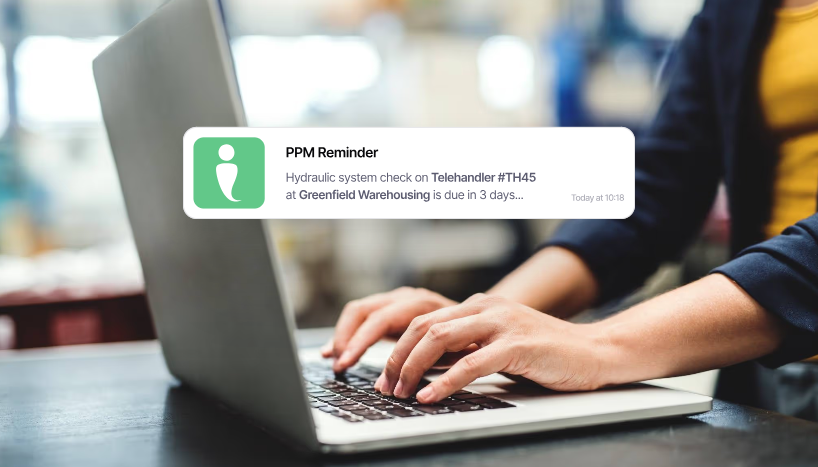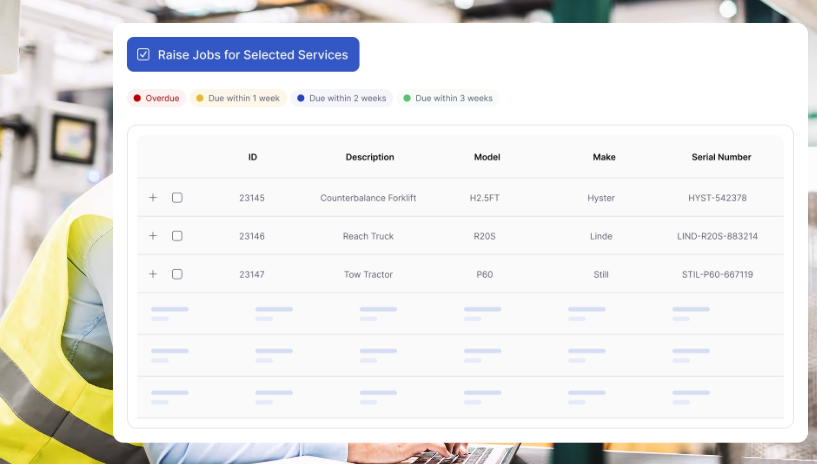What is Planned Preventive Maintenance (PPM)?

Definition of PPM
Planned preventive maintenance (PPM) aims to avoid issues, such as unplanned downtime, as well as prolong the lifespan of equipment/machinery. A proactive maintenance schedule ensures check-ups are performed at regular intervals by specially-trained engineers, with proof of service once complete.
So what does this mean for you - whether you’re an equipment maintenance provider or a manufacturer maintaining your own machinery?
Key Benefits of PPM
- Cost savings: Avoid unplanned downtime and reduce maintenance costs by 25-35%.
- Increased equipment lifespan: Keep equipment in good working order for longer to prolong the life value of each asset.
- Improved safety and compliance: 25-30% of manufacturing fatalities in the UK are related to maintenance activity. PPM mitigates this risk with regular equipment checks.
- Enhanced operational efficiency: Identify and address potential problems before they become major catastrophes.
- Better budget management: Avoid spending 40%+ of the operating budget on maintenance.

Common PPM Strategies and Best Practices
There are 4 approaches you can adopt to planned preventive maintenance:
1. Usage-based maintenance (UBM): Maintenance is scheduled based on how much an asset is used – for example, servicing HVAC units every 5,000 hours.
2. Time-based maintenance: Checks are scheduled at regular intervals, making it better suited to routine tasks. For example, fluid checks on a forklift every 6 months.
3. Condition-based maintenance (CBM): Uses sensors and IoT devices to monitor equipment performance. When a certain tolerance is reached, it alerts you that maintenance is needed to avoid failure. For example, it’s essential that medical devices stay fully operational 24/7/365.
4. Predictive maintenance (PdM): Collates data from monitoring tools and historical data sets to predict potential points of failure. This enables you to pay extra attention to specific pieces of equipment, such as lifting and access equipment, so they’re serviced more regularly.
How to Implement an Effective PPM Programme
This isn’t our first rodeo. And from working with nearly 5k organisations, we see a common theme in what a ‘good’ planned preventive maintenance programme looks like.
Step 1: Assess Your Equipment and Maintenance Needs
- List out the equipment.
- Determine how important it is to maintain ‘business as usual’. For example, if the equipment was to fail, would the company be unable to operate?
- Prioritise your attention and focus. For example, anything related to employee safety is always going to be a top priority, but what about cleaning fans and testing batteries? Is the business likely to shut down if these tasks are pushed out by a week?
Step 2: Schedule and Plan Maintenance Tasks
- Identify which PPM strategy, or blend of strategies, to pursue.
- Think about H&S regulations and the manufacturer’s guidance.
- Explicitly write down when each piece of equipment/machinery is due to be serviced to set expectations and avoid misunderstandings (or use a service management tool to automate this).
Step 3: Track Performance and Make Improvements
- Determine what key performance indicators (KPIs) – for example, mean time to failure – to use to track how effective your PPM is.
- Think about how to use checklists to ensure maintenance tasks are performed the same way every time, regardless of which engineer is on-site (this can also be managed more easily with the right software).
Step 4. Use Technology to Streamline PPM
- Use technology to help schedule PPM jobs, communicate with engineers, track your inventory, and record service histories.

The Cost of Not Having a PPM Plan
As the saying goes ‘failing to prepare is preparing to fail’. And in a worst-case scenario, equipment failure can stop a business from operating.
Then there’s compliance. H&S legislation exists for good reason, as 25-30% of manufacturing fatalities in the UK are related to maintenance activity. If your equipment is found to be at fault, the HSE can impose unlimited fines, put you in jail for 2 years, and order you to pay compensation and victim surcharges, as well as impose community orders, disqualification orders, and publicity orders.
But what about delaying PPM? Surely that’s ok as long as the work gets done?
Not really. Research shows that £1 worth of maintenance deferred can cost 4x in capital renewal costs later on. And running equipment to the point of failure can cost 10x as much as a regular maintenance programme.
Why PPM is Essential for Long-Term Success
Failure to implement planned preventive maintenance is a significant risk, because equipment could break at any moment causing the business to shut down, and employees are working in a potentially unsafe environment.
PPM is also a great foundation to base your long-term relationship on, because everyone ultimately wants to prolong the life of their assets by keeping them in good working order. Through regular servicing and maintenance, you’re best placed to make recommendations on when to retire assets or invest in more equipment.
Software for PPM: Do You Need It?
If you service other people's equipment, rather than your own, take a moment to imagine every client you currently service.
Now imagine every piece of equipment/machinery you maintain for them.
Now consider how much your business intends to grow this year.
There’s only so many numbers a spreadsheet can hold. Not to mention you’ve got to have faith that the document you’re looking at is the most recent version.
Without software, your PPM schedule will quickly transform into an unmanageable beast. And think, one missed statutory check could land you with a fine so big it crushes your business, put you in prison, or leave you with a lifetime of “What ifs”.
The Role of Service Management Software in PPM
Service management software is all about keeping track of assets and the specific maintenance requirements for each piece of equipment – and that’s going to offer you benefits in terms of cost and efficiency savings, operational improvements, strategic advantages…and more!
The following functionality highlights some of the heavy lifting that service management software can do when it comes to your planned preventive maintenance contracts.
- Asset management: At all times you know what equipment you have, where, and in what condition - as well as when maintenance needs to happen.
- Scheduling: If you have engineers in the field, you need to balance a range of scheduled and reactive work and have the right engineer on-site with the skills to complete the job.
- Inventory management: Access to real-time information about stock, sales, purchasing and equipment.
- Accounting integration: Streamlines your business processes, connects users and improves data accuracy, never mind making your life easier!
If you have engineers in the field, service management software will also help you with:
- Quotes: Engineers can accurately price up jobs while in the field, as well as keep track of costs, for example, when ordering parts on-site.
- Invoicing: Because engineers can order parts, submit timesheets and mark jobs as complete from their mobile devices, there’s no delay before invoicing it.
- Time management: With the right module in place, subcontracting work is as simple as allocating a job to one of your own engineers.

How Does PPM Differ By Industry?
While at its core, planned preventive maintenance is about keeping equipment healthy, there are some industry challenges to consider, as outlined in the following sections.
Logistics and Materials Handling
Industry Specific challenges
- High equipment usage: Warehouses, distribution centers, and logistics hubs run 24/7, leading to rapid wear and tear of equipment.
- Downtime impact: Any equipment failure can disrupt supply chains and delay deliveries.
- Regulatory compliance: Health and safety regulations require regular inspections for lifting and handling equipment.
- Mixed asset types: Includes forklifts, conveyors, automated storage systems, and fleet vehicles.
PPM Considerations:
- Asset tracking integration: Ensuring warehouse management systems (WMS) and any other tools used align with PPM schedules.
- Predictive analytics: Using data-driven insights to forecast failures before they occur.
- Compliance tracking: Automating maintenance logs to meet safety standards like LOLER (Lifting Operations and Lifting Equipment Regulations) and PUWER (Provision and Use of Work Equipment Regulations).
Manufacturing and Industrial Equipment
Industry-Specific Challenges:
- High productivity demands: Unplanned downtime can cause major production losses.
- Complex machinery: Machines involve multiple components with different maintenance schedules.
- Quality control dependency: Poor maintenance can lead to defects in manufactured products.
- Safety risks: Industrial machinery poses hazards if not regularly maintained.
PPM Considerations:
- Automated scheduling: Ensuring maintenance occurs during planned production downtimes to minimise disruption.
- Parts inventory management: Keeping track of spare parts to reduce repair time.
- Compliance with industry standards: Adhering to ISO 9001 for quality management and ISO 45001 for workplace safety.
Construction and Heavy Machinery
Industry-Specific Challenges:
- Harsh operating environments: Exposure to dust, debris, and extreme weather accelerates wear and tear.
- Remote job sites: Equipment is often in remote locations, making maintenance logistics more challenging.
- Heavy load stress: Equipment like excavators, cranes, and loaders undergo high mechanical stress.
- Regulatory compliance: Safety standards require rigorous maintenance for heavy machinery.
PPM Considerations:
- Telematics and GPS tracking: Using remote monitoring to assess equipment condition and schedule maintenance.
- On-site servicing capabilities: Deploying mobile maintenance units to minimise downtime.
- Lifecycle-based maintenance planning: Tailoring maintenance schedules to machine usage rather than just fixed time intervals.
- Compliance with safety regulations: Meeting standards such as HSE.
Medical Devices and Equipment
Industry-Specific Challenges:
- Strict regulatory oversight: Devices must meet stringent health and safety standards.
- Patient safety concerns: Malfunctioning equipment can have life-threatening consequences.
- Diverse asset types: Equipment ranges from imaging machines (MRI, CT scanners) to life-support systems and surgical tools.
- Cyber security risks: Many modern medical devices are connected to hospital networks, requiring secure maintenance protocols.
PPM Considerations:
- Regulatory compliance tracking: Ensuring maintenance aligns with standards like MHRA and ISO 13485.
- Calibration and testing: Regular testing to maintain precision and reliability of diagnostic and treatment equipment.
- Data security measures: Implementing cyber security best practices to protect networked medical devices.
- Risk-based maintenance planning: Prioritising maintenance based on criticality to patient care.
See what Service Geeni can do for you...
Service Geeni can make it easy for you to manage your customers, engineers, and equipment – all in one platform.
Download Full PDF
Read More…

Book Your Demo Today







